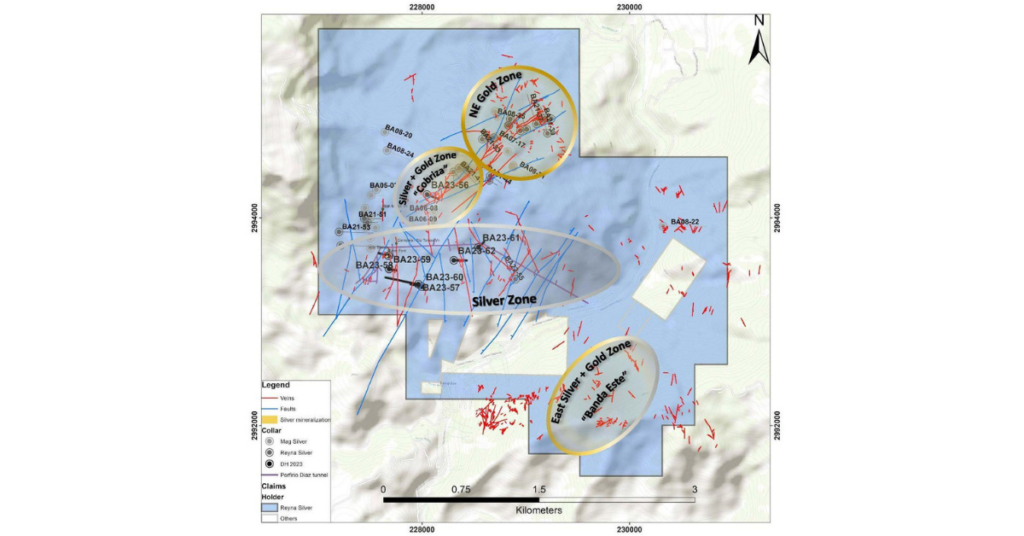VANCOUVER, BC and HONG KONG, CHINA / ACCESSWIRE / September 6, 2023 / Reyna Silver Corp. (TSXV:RSLV)(OTCQX:RSNVF)(FRA:4ZC) (“Reyna” or the “Company”) is pleased to report multiple, near-surface, high-grade, native silver-bearing intercepts in three of the initial holes of its 2023 Batopilas Drilling Campaign. Intercepts include Reyna Silver’s widest to date (BA23-58: 9 m of 616 g/t Silver within 30 m of 218 g/t Ag) and the discovery of a new, blind Native Silver vein reporting 6,440 g/t Silver across 0.2 metres (BA23-57). The holes were drilled in the historic Silver Zone on the district’s west side. Following the end of the rainy season, drilling is expected to resume in both this area and the recently discovered Gold-Silver Zone on the district’s east side.
The targets reported here resulted from a year-long systematic geological re-evaluation of the district, including mapping, sampling, structural, and geophysical studies (See Press Release from June 29, 2023) triggered by Reyna’s 2022 discovery of significant gold (See Press Release from April 12, 2022). Gold was previously unknown at Batopilas, famous as Mexico’s richest Native Silver District, historically producing over 300 Moz of Silver with an average grade of 1,500 g/t Silver.
Highlights from the initial 2023 Batopilas Drilling Campaign (See Table 1).
- Hole BA23-58 cut 9 m of 616 g/t Silver within an overall structure of 30 m width running 218 g/t Silver, including 1.4 m of 1,405 g/t Silver (See Table 2).
- Hole BA23-57 hit a new Native Silver vein grading 6,440 g/t Silver across 0.2 metres in a blind structure between the historically important Escritorio and Todos Los Santos veins. There were also multiple additional intercepts on the way to the new vein (See Drill Results Explanation below and Figure 3).
- Hole BA23-60 cut 0.8 m grading 1,342 g/t Silver 65 m above the Escritorio Vein.
“We are delighted that the time and effort spent over the past year on the sampling program, structural studies, and geophysics has paid off with these high-grade silver discoveries,” said Jorge Ramiro Monroy, CEO of Reyna Silver. “Cutting new native silver structures -including one reporting 9 metres of over 600 g/t Silver- shows that a disciplined, district-scale approach to exploration can lead to discovery. Going forward our team will test this model against our upcoming drill targets in our campaign to search for the silver and gold veins of Batopilas.”
“Finding multiple new, high-grade silver veins through collaborative rethinking of a district with 400 years of mining history proves that solid field work and modern exploration approaches can revolutionize the geologic perception of an ore system. Mining history tells us that the Batopilas Native Silver veins can blossom from a few centimeters to over 2 metres wide in a few metres laterally, so any of these intercepts could be very close to a major shoot,” said Dr. Peter Megaw, Chief Exploration Advisor to Reyna Silver. “Next, we get to turn our sights and drills on targets in the Banda Este Gold-Silver Zone generated through this systematic district reappraisal.”

Table 1. Highlights from Drillholes BA23-57, BA23-58 and BA23-60. Reported widths are core length as true widths for the reported mineralized intervals have not been determined.
Drill Results Explanation and Highlights
The drilling program consisted of six holes, totaling 1,458 metres, targeting areas of interest determined by the yearlong study (See Map 1, 2).
Hole BA23-58 targeted the San Roberto-Roncesvalles vein/structure more than 350 metres NW of BA23-57 in Escritorio. Starting just 3 metres below the surface, it cut an overall 30 m (core length) mineralized zone grading 218 g/t Ag, encompassing multiple high-grade zones (See Table 2). Within these 30 m, starting 9 m down-hole, the drill cut 1.5 m of 398 g/t Ag. Then, at 21 m in depth, 9 m of 616 g/t Ag was cut, including 1.45 m grading 1,405 g/t Ag. At 28.5 m depth, it cut the final high-grade zone of 1.5 m grading 936 g/t (See Highlight Table 1).
Hole BA23-57 was designed to test the top of the Escritorio vein on the way to a target identified through a combination of geophysical, sampling, and structural studies conducted during the 2022-23 systematic exploration program. At 64.5 m downhole, the drill cut the top of the Escritorio vein, which showed 0.25 m grading 1,360 g/t Silver. Then, at 203.2 m, the drill cut a new and completely blind, Native Silver vein grading 6,440 g/t Silver over 0.2 m (See Highlight Table 1 and Figure 3). The technical team is excited by this development because the covered structure lies between the Escritorio and Todos Los Santos veins, two of the most significant veins in the district. Historically, miners would follow narrow silver-rich calcite seams into the famous native silver ore shoots of Batopilas, so follow-up drilling of this new vein is a high-priority exploration goal (See Figures 1 and 2).
Hole BA23-60, also in the Escritorio zone, had a steeper trajectory than BA23-57 and cut the Escritorio Vein at 72.7 m, where it carried 0.8 m of Native Silver grading 1,432 g/t Silver (see Highlight Table 1). The intercept was 50 m below and 15 m south of the BA23-57 intercept and is believed to lie 66 m from any historic workings (See Map 2).

Figure 1. (above):
Schematic Plan View of a Typical Batopilas Ore-Shoot. Native Silver (in blue) occurs sporadically in the narrow calcite veins that link the oreshoots for 30-150 m. Over a distance of 1-8 m, the structure blossoms into steeply-inclined oreshoots, ranging from 0.5 to 2 m wide, 30-80 m on level, and up to 350 m in height. Approaching a shoot, the vein shows a rapid lateral transition from calcite containing fine-grained Galena (lead sulfide, PbS) (in grey), fine-grained Sphalerite (zinc sulfide, ZnS) (in mauve), and finally Proustite (a silver sulfosalt, Ag3AsS3) and Acanthite (a silver sulfide, Ag2S) (in orange) before entering the principal Native Silver ore-zone. As the Native Silver zone is passed, the vein transitions through the sequence in reverse before shrinking back to a narrow calcite seam, which continues 30-150 m to the next oreshoot.

Figure 2. (left): Schematic Cross-Section View of the Batopilas Oreshoot. Native Silver is denoted in blue, fine-grain Galena (PbS) in grey, fine-grain Sphalerite (ZnS) in mauve, the combination of Proustite (Ag3AsS3) and Acanthite (Ag2S) in red. The steeply inclined oreshoots continued down for hundreds of meters in several areas.

Map 1. Major elements of the Batopilas District, within the claim area shown in blue. The purple line is the historic Porfirio Diaz Tunnel. Recent Drill holes are marked in black, and earlier drill holes are in greys, including historic drilling by MAG Silver. Veins are in red, and structures are in blue. The gold and silver ovals highlight the different zones within Batopilas. The NE Gold Zone, the Cobriza Gold + Silver Zone, and the East Gold and Silver Zone (“Banda Este”) were discovered by Reyna Silver.


Map 2. Location map for drill holes described here (in bold) plus historical drill holes (in grey). BA23-57 targeted a structure suspected to exist between Escritorio on the east and Todos Los Santos on the west; it cut 0.25 m grading 6,440 g/t Ag in a previously untouched area. BA23-60 tested Escritorio as well. The BA23-58 intercept is between San Roberto-Roncevalles, 85 metres from the nearest historic stope or adit. BA23-56 was in Pastrana (TD at 190.5 m), BA23-57 was in Escritorio (TD at 450 m), BA23-58 was in Roncesvalles (TD at 140 m), BA23-59 was in Todos Los Santas (TD at 159 m), BA23-60 returned to Escritorio (TD at 159.5 m), BA23-61 was in La Vaca II (TD at 141 m), and BA23-62 was in La Vaca (TD at 222 m).
Future Exploration Plans
These results validate the time Reyna spent systematically rethinking the district’s geology following the discovery of significant Gold mineralization in this historic Silver district (See Press Release from April 12, 2022). This process substantially increased understanding of the Batopilas District and resulted in multiple new drill targets. These six holes represent the first stage of drilling on these new targets, and after a break for the rainy season, rigs will be mobilized to the next major planned target area, the Gold-Silver bearing Banda Este zone. This area rose in priority for the exploration team after significant gold and silver mineralization was encountered by a selective sampling program (See Press Release from September 13, 2022). Banda Este has few historical workings, but Reyna Silver’s work in the district indicates significant potential for it to grow into an important exploration area (See Map 1).
While drilling is underway at Banda Este, the technical team will develop follow-up targets building on the high-silver results reported here. The principal goals will be refining understanding of the structural controls on the Native Silver shoots, identifying vectors to follow the Native Silver intercepts into major oreshoots, and continued investigation of the relationship between the silver and gold mineralization stages that have been recognized.

Table 2. Results from BA23-58 of the full 30 metres grading 218 g/t Ag from 3 to 33 metres.

Figure 3. Close up of NQ-sized core (4.8 cm diameter) from Hole BA23-57 with Native Silver vein grading 6,440 g/t Silver over 0.2 metres. Note threads of shiny metallic Native Silver in the upper vein zone and the black acanthite (silver sulphide Ag2S) filling breccia in the middle of the vein. This is the style of mineralization seen historically in the district approaching major mineralized shoots.
QA/QC STATEMENT
Reyna Silver follows industry standard procedures for diamond core drilling and sample analysis. Drilling is carried out using NQ and HQ size tooling. The drill core is cut in half using a diamond rock saw, with one-half of the core then taken as a sample for analysis and the other kept as a register. Sample intervals are generally from 0.2 to 2 m intervals, producing samples of between 0.6 to 10 kg. Half-core samples are delivered to the internationally certified ALS Minerals laboratory facilities in Chihuahua City, where the samples are prepared. ALS has a Quality management system (ISO 17025), and Assays are completed by ALS Minerals in Canada. The samples are fire-assayed for Au (Au-23) and are analyzed for Ag and multi-elements using method code ICP (ICP-41) following an aqua regia digestion. Samples showing visible gold are resubmitted to ALS for Metallic Screen Assaying. Overlimits are analyzed using an appropriate method. Multi-element geochemical standards and blanks or duplicates are inserted systematically into the drill core sampling series to monitor lab performance. The control samples are inserted every 25 samples in the case of standards, blanks, and field duplicates, and for rejects and pulps duplicates, every 30 samples are intercalated. Referent to the chain of custody, the samples are transported from Batopilas by Reyna Silver personnel to ALS Chemex in Chihuahua City.
QUALIFIED PERSON
Dr. Peter Megaw, C.P.G., the Company’s Chief Exploration Advisor and Qualified Person, reviewed the technical aspects of the exploration projects described herein and is responsible for the design and conduct of the exploration program and the verification and quality assurance of analytical results. Dr. Megaw is not independent as he and/or the companies with which he is affiliated hold Net Smelter Royalties on the Guigui and Batopilas Projects that predate Reyna Silver acquiring them.
ABOUT REYNA SILVER
Reyna Silver Corp. (TSXV: RSLV) is a growth-oriented junior exploration and development company focused on exploring for high-grade, district-scale silver deposits in Mexico and USA.
Reyna’s principal properties are the Guigui and Batopilas Properties in Chihuahua, Mexico, plus Medicine Springs and Gryphon Summit in Nevada, USA. Guigui covers the interpreted source area for the Santa Eulalia District, and Batopilas covers most of Mexico’s historically highest-grade silver system. The Company also has an option to acquire 100% of the Medicine Springs CRD project in Elko Co., Nevada, USA, and the 10,300-hectare combined Carlin-style and CRD Gryphon Summit Project in Eureka Co., Nevada, USA, as well as several early-stage properties in Mexico.
Cautionary Statements
This document contains “forward-looking statements” within the meaning of applicable Canadian securities regulations. All statements other than statements of historical fact herein, including, without limitation, statements regarding exploration results and plans, and our other future plans and objectives, are forward-looking statements that involve various risks and uncertainties. Such forward-looking statements include, without limitation, our estimates of exploration investment, the scope of our exploration programs, and our expectations of ongoing administrative costs. There can be no assurance that such statements will prove to be accurate, and future events and actual results could differ materially from those anticipated in such statements. Important factors that could cause actual results to differ materially from our expectations are disclosed in the Company’s documents filed from time to time via SEDAR with the Canadian regulatory agencies to whose policies we are bound. Forward-looking statements are based on the estimates and opinions of management on the date the statements are made, and we do not undertake any obligation to update forward-looking statements should conditions or our estimates or opinions change, except as required by law. Forward-looking statements are subject to risks, uncertainties and other factors, including risks associated with mineral exploration, price volatility in the mineral commodities we seek, and operational and political risks. Readers are cautioned not to place undue reliance on forward-looking statements.
SOURCE: Reyna Silver Corp.
Original Article: https://www.accesswire.com/781001/reyna-silver-drills-multiple-new-native-silver-veins-at-batopilas-including-9-m-at-616-gt-silver


















